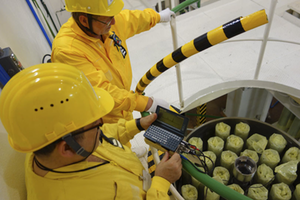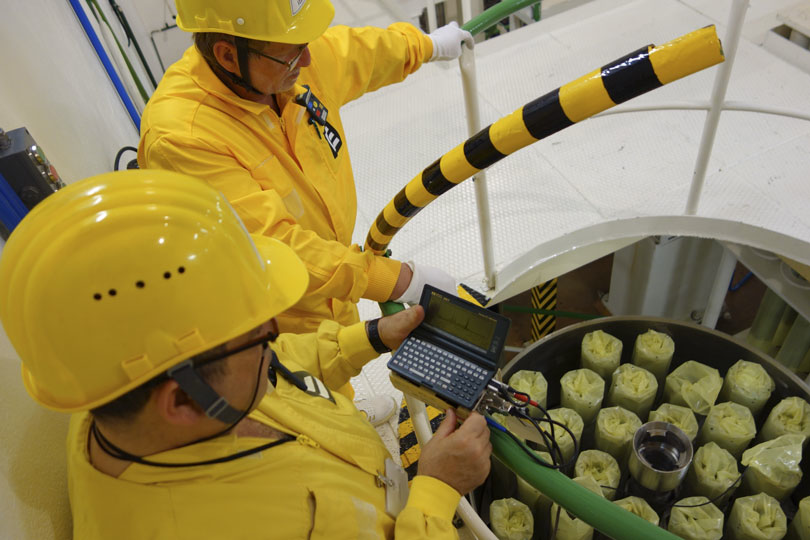Nuclear Monitoring with Antineutrinos
Nuclear power plants can produce plutonium for weapons, so international inspectors would like a system that could tell from the outside whether material has been removed from a reactor. In Physical Review Letters, researchers describe a system that could monitor the state of the reactor core by detecting the antineutrinos it emits. The system would require improvements beyond today’s detector technology, but experts say that such advances could be available in several years.
Nuclear reactors emit around antineutrinos per second, making them the most intense artificial neutrino sources on Earth. Physicists first considered antineutrinos for reactor monitoring over years ago, but detector capabilities were limited at the time. However, “neutrino detectors have gotten much better in the last five years,” thanks to several hot areas of neutrino research, says Patrick Huber of Virginia Tech in Blacksburg. Current research on the details of reactor physics could potentially allow a detector to sit near a reactor and distinguish reactor antineutrinos from the background due to cosmic rays.
Such a system would include a large amount of a scintillator material such as mineral oil or plastic. A high-energy antineutrino (greater than mega-electron-volts) striking a proton in the scintillator would produce a positron (antielectron) and a neutron, with most of the kinetic energy in the positron. The system would measure the positron’s energy based on the flashes of light it produces as it decelerates in the scintillator.
Currently nonproliferation safeguards include cameras, seals, and other equipment, which the International Atomic Energy Agency (IAEA) uses to track nuclear material in a reactor facility. But monitoring can be interrupted by technical glitches or diplomatic standoffs, as occurred with North Korea a few years ago. During these interruptions, a proliferator could surreptitiously remove some plutonium-enriched material generated by the reactor and use it for weapons development, replenishing the reactor with fresh uranium fuel. Returning inspectors would have no way to detect such a plutonium diversion, short of shutting down the reactor and making expensive and lengthy measurements of the core. An antineutrino detector would allow inspectors to determine the state of the core after a period of absence and could also allow an honest nation to reassure the international community that fuel has not been removed, says Huber.
In a paper currently in peer review, Huber’s team showed theoretically that antineutrino detectors could have probed the North Korean reactors upon the inspectors’ return with only about days of data-taking [1]. The researchers have now redone their analysis using publicly available information on the IR- reactor in Arak, Iran. They imagined tons or less of scintillator in a detector system placed in a mobile shipping container and parked just outside the reactor building (roughly meters from the core). This close proximity would provide enough antineutrinos to allow measurements to be completed within the IAEA’s required time of days, the team found.
Unlike previously proposed antineutrino monitoring systems, this detector would provide a spectrum—the distribution of antineutrino energies. Plutonium antineutrinos have less energy on average than those produced by uranium, so the shape of the spectrum can reveal the level of plutonium in a reactor. Based on their analysis, the team says the system could detect whether as little as kilograms of plutonium had been removed from the reactor. They also analyzed other scenarios where an antineutrino detector could perform as a nuclear watchdog.
The researchers acknowledge that their system will require technological advances. Distinguishing reactor antineutrinos from the cosmic-ray background has so far only been possible underground, except in one recent above-ground experiment, where the system was not sensitive enough to collect useful spectra [2].
Huber believes Iran would benefit from hosting a cutting-edge antineutrino detector because it could reassure the world community and because Iranian physicists could take part in the research. “Scientific exchanges such as this can build bridges,” Huber says.
Adam Bernstein of Lawrence Livermore National Laboratory in California says the proposed system “is potentially workable in a technical sense.” But he points out that it cannot be done with current technology. A number of antineutrino experiments are currently being built with specifications similar to what would be needed for nuclear monitoring, says Antonin Vacheret of Oxford University in the UK. “So it is possible that in a matter of years we will have made a substantial leap that could lead to a demonstration in the field,” he says.
–Michael Schirber
Michael Schirber is a Corresponding Editor for Physics Magazine based in Lyon, France.
References
- E. Christensen, P. Huber, and P. Jaffke, “Antineutrino Reactor Safeguards - A Case Study,” arXiv:1312.1959 (2013)
- S. Oguri, Y. Kuroda, Y. Kato R. Nakata, Y. Inoue, C. Ito, and M. Minowa, “Reactor Antineutrino Monitoring with a Plastic Scintillator Array as a New Safeguards Method,” Nucl. Instrum. Meth. 33, (2014)





